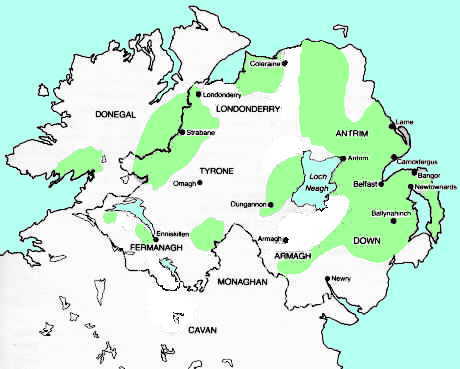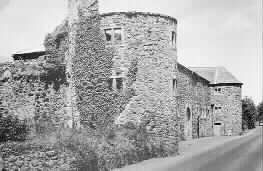Although Scots had been settling in Ireland and more particularly Ulster for hundreds of years, it was not until 1606 that a major plantation occurred.
The plantation was masterminded by two men, James Hamilton and Hugh Montgomery. Both were native scots but each saw major benefits in a settlement which would undoubtedly leave them as powerful landowners in Ulster.
The main player was Hugh Montgomery who in a dramatic episode helped a prominent Irish chieftain, Con O'Neill escape from jail in Carrickfergus. In return Con O'Neill was to sign over a major proportion of his lands of Upper Clannaboye (modern day Nth Down) to Montgomery.
However Montgomery's plan was disrupted by the efforts of James Hamilton. Upon hearing of Montgomery's exploits, Hamilton persuaded King James I that O'Neill's lands should be split three ways and thus the bedrock was layed for the plantation.
The settlers were mainly lowland scots from Ayrshire, Lanark, Wigton and of course the Borders. They were mainly lowland farmers involved in both arable farming and rearing cattle. However the Border families who came with them had a much more colourful background.
These borderers were the notorious Reivers; warlike clans who had existed in a society where survival came through strength in combat and bounty obtained in murderous raids on other Reivers.
Although these Reivers were not the mainstay of the settlement their influence was enormous and there is little doubt that those organising and funding the settlement felt the risks of their inclusion were outwayed by the benefits.
The plantation was focused on the land known as Upper Clannaboye (modern day North Down) with the first sizable settlements begining at Donaghadee and Newtown(Newtownards) -
Map showing extent of Scots-Irish plantation
These early settlers undertook the work of the plantation with enormous energy and within a short while produce was being exported in abundance. This new land showed enormous potential with fertile pasture, rivers teaming with fish and extensive areas of woodland.
However the early aspirations of the settlers was tempered with the knowledge that the native Irish peoples of the area had not been enthusiastic at their arrival and indeed some who had been displaced from their lands by this and earlier plantations were intent on revenge.
This led to the need to be watchful of raids and attacks by groups of native Irish known as 'woodkern'; named so because of their habit of hiding in dense woodland and attacking travellers or families in their area. Amongst the early settlements, fortified houses called 'bawns' began to be built as these at least gave their occupants some protection.
With the help of such buildings and stubborn determination (later to be seen as the hallmark of the Scots-Irish) the settlement began to extend throughout Ulster. Hostility with the native Irish was limited due to the lack of co-ordination in their attacks. However, as time would prove, this situation was about to change dramatically.
A typical Bawn House of the early 1600s


